Keyboard Shortcuts
1. Ctrl-L to Cut Line to Clipboard



It’s not necessary to highlight an entire line and then hit the delete key. Just hit “Ctrl-L” and the line the cursor is currently on will be removed and copied to the clipboard. “Ctrl-x” performs the same operation by default.
2. Shift-F5 to Stop Debugging



To stop debugging a project, use “Shift-F5”. Much quicker than going through the Debug menu.
3. Create new property





Add a new property in code by typing prop then hitting the Tab key twice. This “prop-TAB-TAB” combination will create a property template that looks like:
1: public int MyProperty { get; set; }
4. Comment/Uncomment code





You can comment or uncomment code by highlighting the respective code block and hitting “Ctrl-k-c” to comment or “Ctrl-k-u” to uncomment. This shortcut even works in .aspx pages.


5. Reformat a block of code





If you’ve just pasted in a bunch of code where the formatting is screwed-up, just highlight it and hit “Ctrl-k-f” to format.
6. Reformat entire document





If you want to reformat all of the code in the current document, hit “Ctrl-k-d”.
7. Find matching curly brace or region



Position the cursor next to a curly brace (‘{‘ or ‘}’) and hit “Ctrl-}’. This will toggle the cursor between the matching braces.
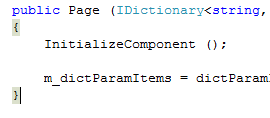
This shortcut will also work for #region…#endregion’s.
8. View coding window full-screen





Hitting “Alt+Shift+Enter” will make the coding window full-screen and (temporarily) drop most other windows from view. Restore to your usual window configuration by de-pressing the “Full Screen” button at top:
9. Search without the dialog








Just highlight the text you want to search on and hit “Ctrl-F3” to search down or “Ctrl-Shift-F3” to search up.
10. Toggle Outlining





If you want to open (expand) or close (collapse) all outlining in a code file, use “Ctrl-k-l”. It works like a toggle, alternatively expanding or collapsing all outlining in the current file.
11. Code Snippets





Easily open a code snippets selection dropdown with “Ctrl-k-s”:

12. Go to Definition

Put the cursor on an item and hit ‘F12’. Instant ‘go to definition’ functionality.
13. Add/Remove Breakpoint

‘F9’ will toggle breakpoints for the current line.
14. Find Usages



‘Shift-F12’ will find all usages of the item the cursor is currently on and display the “Find Usages” dialog (this is ReSharper’s version of the dialog; standard VS2008 looks a little different):
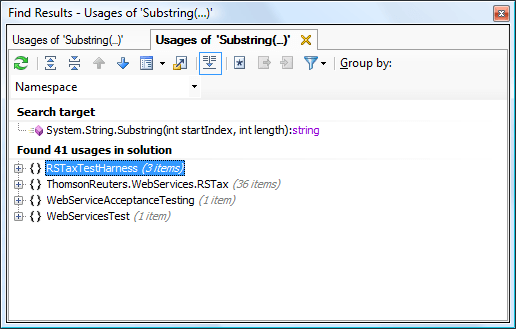
Mouse Shortcuts
1. Right-click to add references
Say you’ve just entered a line of code like the following where the red squiggly indicates you haven’t yet added the necessary reference:
![]()
You could jump to the top of the file and type it in manually, or you could right-click on the squiggly-indicated word and choose “Resolve | using …”:
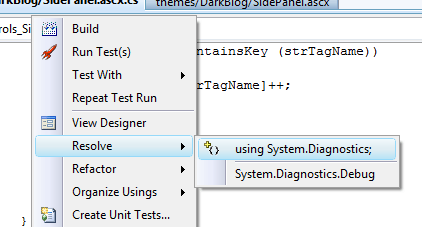
This will add the needed reference for you, no typing required.
2. Remove unused references
Many times there are references included in the “using…” section that are not needed. Removing the unnecessary ones is easy: Right-click anywhere on the code file, select “Organize Usings | Remove Unused Usings”.
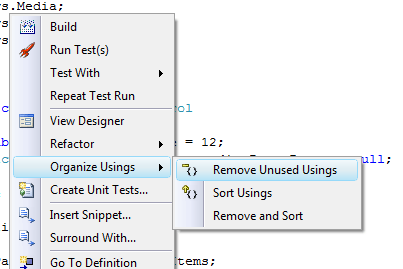
3. Sort usings
To sort your “usings…” section, right-click anywhere on the code file and select “Organize Usings | Sort Usings”.
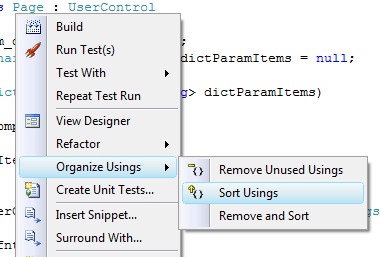
4. Open a file’s “containing folder”
Right-click on an open file’s tab, select “Open Containing Folder”.
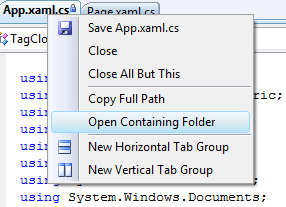
5. Copy a file’s folder location to the clipboard
Right-click on an open file’s tab, select “Copy Full Path”.
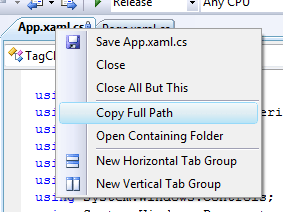
6. Close all files but “this” one
If you have more than one file open, you can right-click on one of the file tabs (the one which you want to stay open) and choose “Close All But This”. This will close all other files.
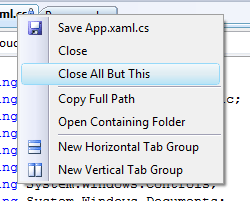
7. Close tab
A quick way of closing a tab is to use the mouse scroll button. Hover the mouse cursor over the tab, click the mouse scroll button, and the file (and it’s tab) will close.
